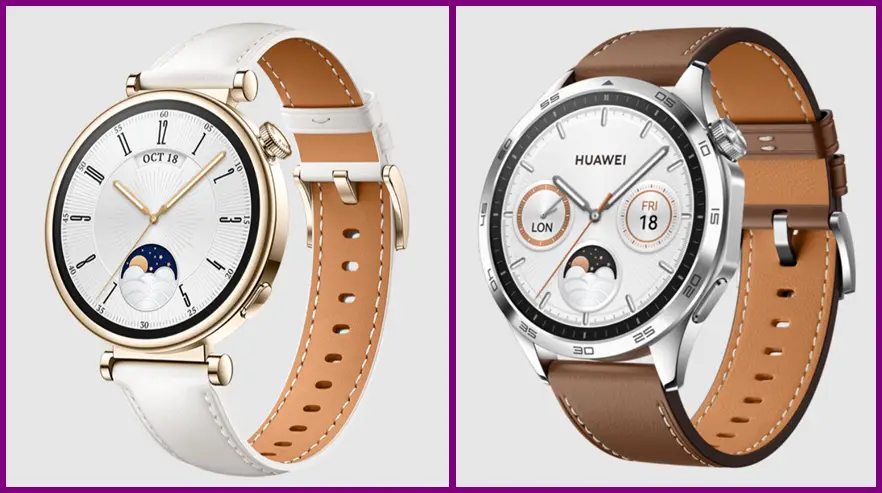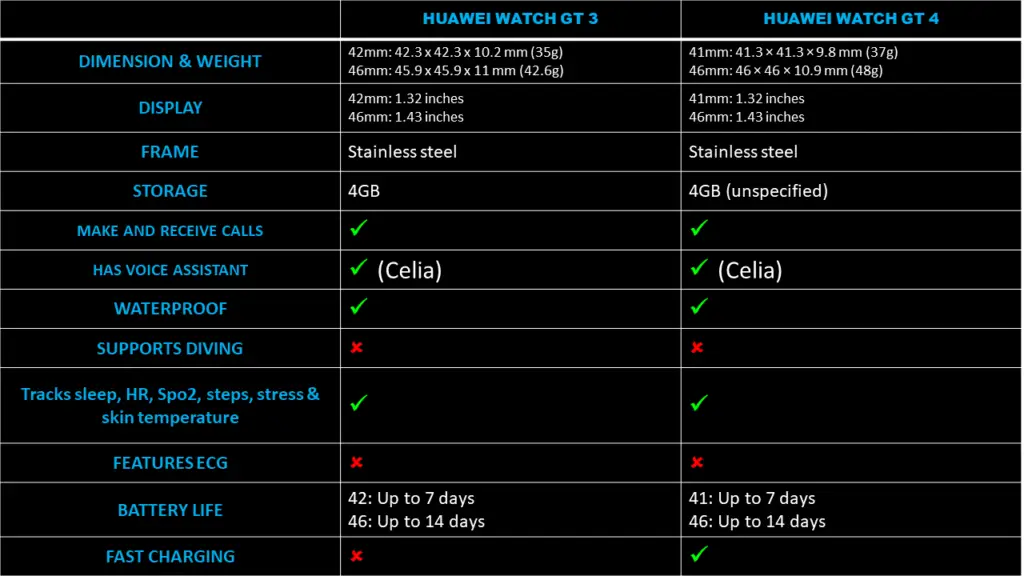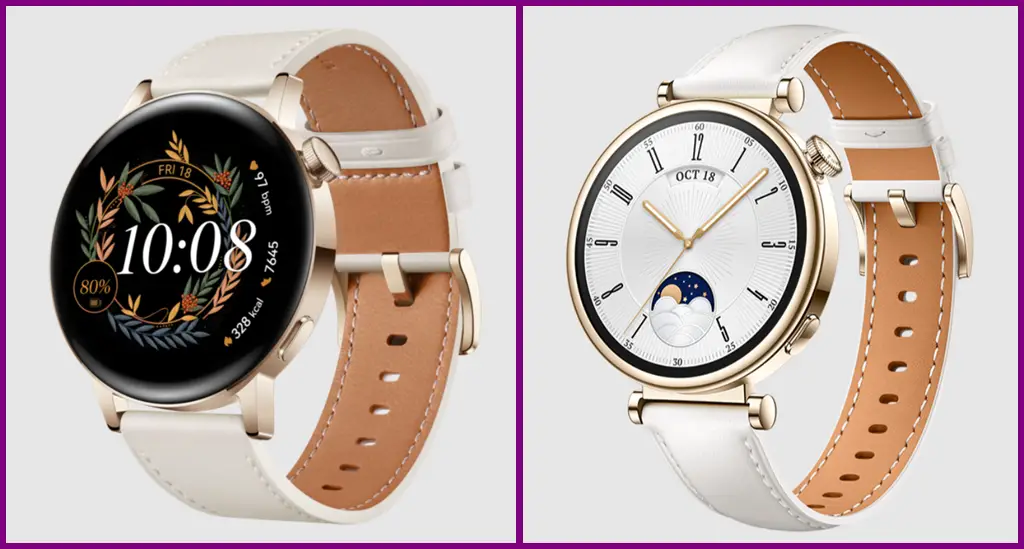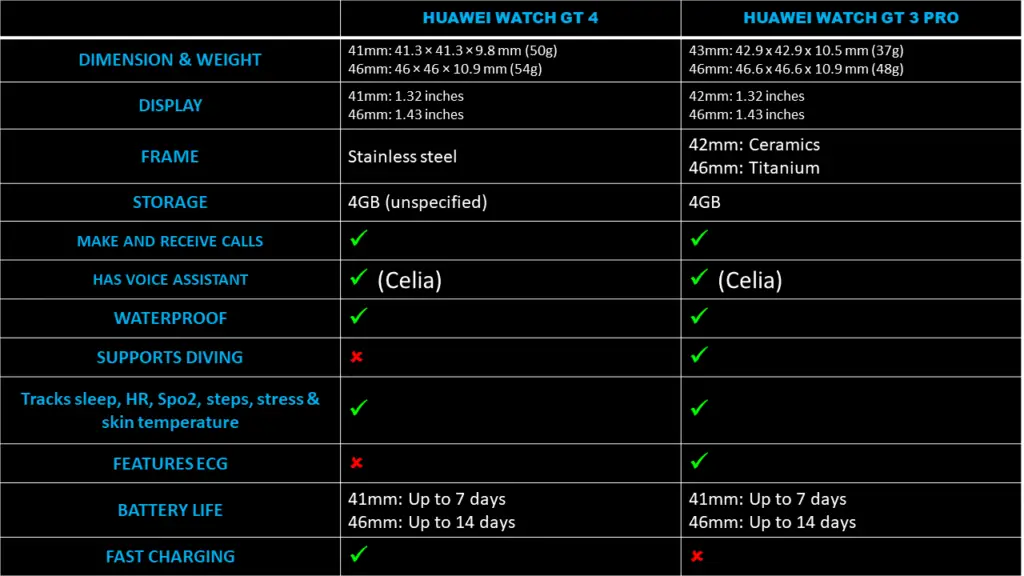It started with the Huawei Watch GT, followed by the GT 2/GT 2 Pro, and then the GT 3/GT 3 Pro. The latest now is the GT 4 with the GT 4 Pro yet to be released. Each of the GT units comes in two sizes and of course, the Pro models have more premium build and features than the non-pro models. In this post, we’ll be comparing the GT 3 vs GT 4 vs GT 3 Pro vs GT 4 Pro to find out the differences.

Huawei Watch GT 3 vs GT 4 vs GT 3 Pro vs GT 4 Pro Full Specifications
Huawei GT 3 vs GT 4: What’s the Difference?
Looking at what the GT 4 brings to the table and going by this review, I can clearly say the GT 4 is not a worthy upgrade from the GT 3. Nonetheless, it has a fantastic design and the health tracking features are numerous. Plus, it has a long battery life that lets you go days from a single charge.

Like the GT 3, the GT 4 has a 1.32/1.43 inches AMOLED powered display which is very colorful, bright and easy to read even on very sunny days. And the frame material is also the same stainless steel.
Furthermore, like its predecessor, the GT 4 also has a speaker and microphone that allows it to receive and answer calls when your phone is nearby. Huawei’s voice assistant, Celia, is also present.
Moreover, like the GT 3, the GT 4 will track your pause rate, blood oxygen, sleep, stress, calories and of course, steps. The skin temperature sensor in GT 3 is also in GT 4. And like its predecessor, the GT 4 is equipped to utilize both L1 and L5 satellite signals to more accurately map routes. You get over 100 sports modes on the GT 4.
In terms of battery life, it’s still the same up to 7 days for the smaller unit and up to 14 days for the 46mm unit.
You can see that the GT 4 shares a lot in common with its predecessor, the GT 3.
So what’s different between the GT 3 and GT 4?
Obviously, the only difference I could find is the different size options and the so-called improved heart rate tracking, thanks to Huawei’s TruSeen 5.5.
While the GT 3 comes in 42 and 46mm sizes, the GT 4 comes in 41mm and 46mm sizes. Moreover, the GT 4 is a tad slimmer but weighs a little more.

I also noticed that while the GT 4 46mm unit looks very similar to the 46mm unit of the GT 3, their smaller units have different appearance. The 42mm unit of GT 3 has a screen that rises above the bezel, in contrast, the bezel of the GT 4 (41mm) rises above the screen which provides some sort of protection for the screen.
Beyond the difference in sizes and appearance, the GT 4 comes with Huawei’s TruSeen 5.5 which is an upgrade to TruSeen 5.0 in GT 3. Huawei claims TruSeen 5.5 provides more accurate tracking results for your heart rate.
Interestingly, the prices of the GT 3 and GT 4 are relatively the same. Nothing much has changed in that aspect.
Huawei didn’t specify the storage capacity of the GT 4 but I presume it’s probably the same 4GB storage as the GT 3. This will allow you to load music to the watch which you can listen to offline via the speakers or a headphone.
Like I said earlier, the GT 4 is a fantastic watch but it’s not a radical upgrade from its predecessor.
Huawei Watch GT 4 vs GT 3 Pro: The Differences
The GT 3 Pro also shares a lot in common with the GT 4, though it has a more durable build and additional features.

Like the GT 4, the GT 3 Pro has inbuilt GPS with dual-band GPS support. It is also equipped with sensors that enable it to track your heart rate, calories, sleep, steps, blood oxygen, stress and skin temperature. The display size and battery life are also the same.
However, the GT 3 Pro has a more durable build. While the GT 4 has a stainless steel build for both the 41mm and 46mm units, the GT 3 Pro 46mm unit has a titanium frame while the screen is sapphire glass. Meanwhile, the 42mm unit of the GT 3 Pro has a nanocrystalline Ceramic frame. Moreover, the GT 3 Pro also features ECG monitoring which is not present in the GT 4.
As a result of the more durable build and ECG function, the GT 3 Pro has a higher price tag than the GT 4.

